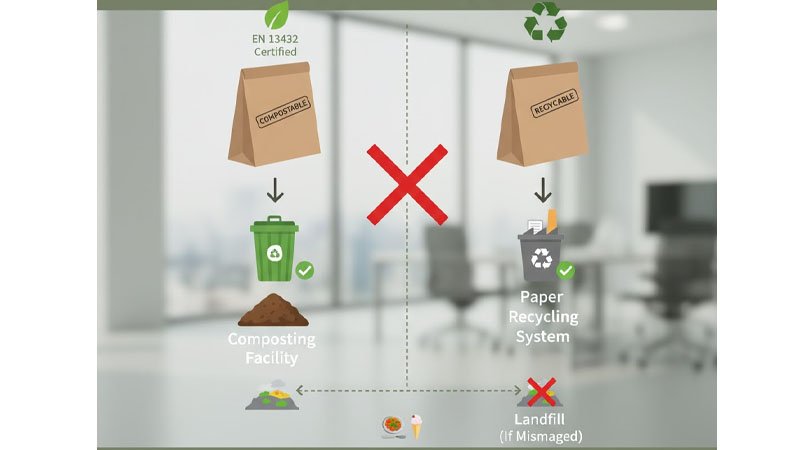Picture this: a major brand launches “eco-friendly” packaging, but the bags end up in landfills anyway — labeled compostable, but not accepted by local facilities. That’s a waste — of time, money, and credibility. The packaging world is full of green promises, but not all of them break down equally.
Here’s the truth: Compostable and recyclable paper bags serve different sustainability goals. EN 13432 defines compostability, while paper recycling systems have different requirements. Understanding both helps avoid greenwashing and gets your packaging truly eco-smart.
Don’t worry — I’ll keep this jargon-free. Let’s break it down like we’re sipping tea in my office at GreenWing.
What Does “Compostable” Actually Mean — and What Is EN 13432?
When someone tells me their bag is “compostable”, my first question is: Certified how? By whom? That’s where EN 13432 comes in.
EN 13432 is the European standard for compostable packaging. It’s strict, and that’s a good thing. To meet EN 13432, a product must:
- Biodegrade 90% in 6 months in industrial composting conditions.
- Disintegrate into small pieces in 3 months.
- Leave no toxic residue that affects plant growth.
- Contain limited levels of heavy metals.
This is not just about paper — inks, adhesives, coatings must also meet the same standards. That’s the part many forget.
So What’s the Difference Between Compostable and Recyclable Paper Bags?
Let’s keep it simple.
- Compostable paper bags are designed to break down into organic matter — ideally in a commercial composting facility.
- Recyclable paper bags are meant to be processed and reused in paper recycling systems.
You can’t just toss compostable bags into the recycling bin. That contaminates the stream. And recyclable bags don’t belong in composting — they won’t break down properly.
In short: different systems, different goals.

How Do These Play Out in Real-World Recycling Systems?
Here’s where it gets interesting — and messy.
Paper recycling systems are built for clean, uncoated paper. Add grease, food residue, or biodegradable plastics, and the whole batch can be rejected.
On the flip side, composting infrastructure is limited. Most regions don’t have enough commercial composting facilities, and home composting doesn’t reach the required temperature for EN 13432 materials.
That’s why many “compostable” bags just end up in landfills. I know — ironic, right?
Which Is More Eco-Friendly: Compostable or Recyclable?
I get this question all the time. The answer? It depends on your supply chain.
- Recyclable bags are great where there’s strong paper recycling infrastructure.
- Compostable bags are better for products that create food contamination (think: grease-stained takeaway bags).
Want my take? Hybrid doesn’t help. Don’t try to make one bag do both. That’s like trying to fry an egg and ice cream at the same time.
You’ll also want to consider the end-of-life behavior:
- Recyclable = reuse of material
- Compostable = return to nature
Common Mistakes Brands Make (Don’t Be That Guy)
Here are some classic oopsies I’ve seen from importers and even big-name brands:
- Choosing compostable paper with conventional ink — which voids the EN 13432 status.
- Labeling bags “recyclable” but laminating them with plastic films — totally unrecyclable.
- Using green logos with no certification — classic greenwashing.
If your product doesn’t meet EN 13432 in full, don’t call it compostable. And always ask your supplier (like us ) for proper documentation.
What We Do at GreenWing (And How We Help Brands Avoid These Traps)
At GreenWing, we manufacture both certified recyclable and EN 13432-certified compostable paper bags. Our secret? Fully integrated production.
- We control everything — paper sourcing, ink formulation, adhesives, even post-print lamination.
- Our inks are water-based or soy-based, compliant with compostable standards.
- We issue full certification packs with every compostable order, so you’re never left guessing.
And yeah — we test them ourselves before shipping. No surprises.

So… Which Type Should You Choose?
Here’s how I guide clients like Mike (our imaginary food brand owner in the U.S.):
- If your bags will touch food (grease, sauces, oils) and the region has composting infrastructure → compostable may be worth it.
- If your supply chain is clean and you want cost-effective eco-friendliness → go recyclable.
But if you’re not sure? Let’s talk. One 10-minute call with our team can save you from a 6-month mistake.
Conclusion
Compostable and recyclable paper bags serve very different purposes, and EN 13432 is not just a sticker — it’s a strict science. Pick the right material for your product, market, and disposal stream. Or better yet, let us help you choose wisely.







